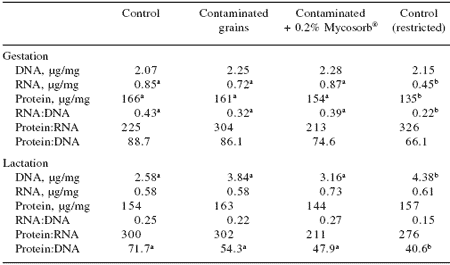Effects of feed-borne Fusarium mycotoxins on metabolism and reproduction in gestating and lactating sows: response to Mycosorb®
There are numerous reports indicating that weanling piglets (Friend et al., 1982, Döll et al., 2003) and growing and finishing pigs (House et al., 2002; Dänike et al., 2004) are particularly sensitive to feed-borne Fusarium mycotoxins. The major symptom seen in pigs consuming deoxynivalenol (DON, vomitoxin)-contaminated feed is reduced feed intake resulting from altered brain neurochemistry including elevated brain concentrations of serotonin (Swamy et al., 2002). Other symptoms include reduced tissue protein synthesis (Dänike et al., 2006) and immunomodulation (Swamy et al., 2003).
Much less is known, however, about the potential for feed-borne Fusarium mycotoxins to influence metabolism, reproduction and lactation of sows. Friend et al. (1983) reported that sows fed naturally contaminated wheat containing 3.45 mg DON/kg feed exhibited a significant reduction in feed intake, weight gain, fetal length and fetal weight at 50 to 54 days of gestation. Chavez (1984) reported that feeding diets based on naturally contaminated wheat containing 1.3, 2.4 or 3.3 mg DON/kg to sows for the last 90 days of pregnancy did not result in reduced feed intake although a significant reduction in weight gain was observed with the highest level of DON.
The use of different mycotoxin adsorbents to prevent mycotoxicoses by preventing intestinal uptake of mycotoxins has been reviewed (Ramos et al., 1996). The polymeric glucomannan mycotoxin adsorbent extracted from the cell wall of yeast (Mycosorb®, Alltech Inc.) has been shown to prevent many aspects of Fusarium mycotoxicoses in starter pigs (Swamy et al., 2002), horses (Raymond et al., 2003), broilers (Swamy et al., 2004), broiler breeders (Yegani et al., 2006) and layers (Chowdhury and Smith, 2004).
Experiments were conducted, therefore, to determine the effect of feed-borne Fusarium mycotoxins on reproduction and metabolism in sows and to determine the efficacy of Mycosorb® in preventing these effects.
Materials and methods
Experiment 1 was conducted to determine the effects of feeding a blend of corn and wheat naturally contaminated with Fusarium mycotoxins to gestating and lactating sows (Díaz-Llano and Smith, 2006; 2007). A total of 36 first parity Yorkshire gilts (12 per diet) were housed in individual stalls for 21 days before farrowing and 21 days after farrowing.
During gestation, feed was restricted to 2.4 kg/pig/day. Diets included: (1) control (2) contaminated grains (3) contaminated grains + 0.2% Mycosorb®. Parameters measured included body weight change, feed consumption, numbers and weights of piglets born, numbers of stillborn and mummified piglets, milk composition, viability of piglets until weaning, blood chemistry and weaning-to-estrus interval.
In Experiment 2, a total of 32 first parity Yorkshire gilts (four diets with eight gilts per diet) were used under similar experimental conditions to those in the first experiment.
Diets included: (1) control (2) contaminated grains (3) contaminated grains + 0.2% Mycosorb® (4) restricted feeding of control diet (80% of control diet consumption).
Blood samples were taken one week before farrowing and 10 days after farrowing. Serum was analyzed for concentrations of ammonia, protein and urea. Biopsies of triceps muscle were taken at the same times and were analyzed for concentrations of DNA, RNA and protein.
DETERMINATION OF DIETARY MYCOTOXIN CONCENTRATIONS
Dietary contents of 19 mycotoxins including DON, 3-acetyl DON, 15-acetyl DON, nivalenol, T-2 toxin, iso T-2 toxin, acetyl T-2 toxin, HT-2 toxin, T-2 triol, T-2 tetraol, fusarenone-X, diacetoxyscirpenol (DAS), scirpentriol, 15-acetoxyscirpentriol, neosolaniol, zearalenone, zearalenol, aflatoxin and fumonisin were analyzed by gas chromatography and mass spectrometry (Raymond et al., 2003). The detection limits were 0.2 mg/kg with the exception of aflatoxin and fumonisin, which were detected at 0.02 and 2 mg/kg respectively.
Results and discussion
DIETARY MYCOTOXIN CONCENTRATIONS
The concentrations of detected mycotoxins in diets fed in Experiments 1 and 2 are given in Table 1. The major contaminant in both experiments was DON with lesser amounts of 15-acetyl DON and zearalenone. All other mycotoxins were found in concentrations below the limits of detection.
Table 1. Dietary mycotoxin content (mg/kg, as-fed basis).
EXPERIMENT 1
There was no effect of diet on average daily feed intake of gilts in gestation (Table 2).
Weight gain and gain:feed ratios, however, were reduced by contaminated grains and this was prevented by dietary addition of Mycosorb®. Serum chemistry was unaffected by diet. The percentage of stillbirths was higher and the total piglets born was lower for gilts fed contaminated grains compared to those fed contaminated grains + Mycosorb®.
There was no effect of diet on frequency of mummies at birth or body weight of piglets at birth. In the lactation period, feed intake and weight gain were reduced by diets containing contaminated grains (Table 3). Blood chemistry, milk composition and piglet weights at weaning were not affected by diet. There was a strong trend, however, to increased weaning-to-estrus interval when sows were fed contaminated grains.
Table 2. Effect of feeding blends of grains naturally contaminated with Fusarium mycotoxins on performance of gestating gilts (Experiment 1)1.
1Adapted from Díaz-Llano and Smith (2006).
a,bMeans within columns differ (P<0.05).
Table 3. Effect of feeding blends of grains naturally contaminated with Fusarium mycotoxins on performance of lactating sows (Experiment 1)1.
1Adapted from Díaz-Llano and Smith (2007).
a,bMeans within columns differ (P<0.05).
It was concluded that feeding grains naturally contaminated with Fusarium mycotoxins to gestating and lactating sows results in increased numbers of stillborn piglets but piglets that are born alive are viable and thrive throughout the lactation period. This is likely achieved, moreover, by a marked depletion of body reserves resulting in trend towards increased weaning-to-estrus intervals.
EXPERIMENT 2
The second experiment was conducted to determine the relative importance of reduced feed intake and impaired protein metabolism in triggering weight loss in lactation. The effects of diet on weight gain and feed consumption in gestation and lactation are given in Table 4. These parameters followed the trends seen in Experiment 1 with feed intake significantly reduced in sows fed the contaminated diet in lactation.
Serum ammonia, protein and urea concentrations are given in Table 5. There was a trend towards elevated ammonia levels in sows fed the contaminated diet during gestation. This could have contributed to the increase in stillborn piglets in this group. The trend towards reduced serum ammonia levels in pigs fed Mycosorb® may be due to the ability of Mycosorb® to adsorb ammonia in the lumen of the intestinal tract and thereby reduce blood ammonia levels and the frequency of stillborn piglets.
Table 4. Effect of feeding blends of grains naturally contaminated with Fusarium mycotoxins on performance of gestating and lactating sows (Experiment 2).
a,bMeans within a row differ (P<0.05).
Table 5. Effect of feeding blends of grains naturally contaminated with Fusarium mycotoxins on serum chemistry of gestating and lactating sows (Experiment 2).
a,bMeans within a row differ (P<0.05).
Protein, DNA and RNA content of muscle tissues are given in Table 6. There was a significant decrease in RNA, protein and RNA:DNA ratios in restricted-fed pigs compared to controls. This would imply reduced cellular transcription rates in pigs undergoing restricted feeding. There was also a trend towards a reduced protein:DNA ratio in these pigs, which would indicate reduced rates of muscle protein synthesis.
In lactation, the pigs fed restricted amounts of the control diet had increased muscle DNA concentrations compared to controls, indicating shrinking of muscle cells. The significant decline in the muscle protein:DNA ratios in these pigs reflects reduced cellular protein synthesis.
There was only a trend in this direction for pigs fed the contaminated diets.
Table 6. Effect of feeding blends of grains naturally contaminated with Fusarium mycotoxins on muscle DNA, RNA and protein content in gestating and lactating sows (Experiment 2).
a,bMeans within a row differ (P<0.05).
| Conclusions It can be concluded that feeding diets naturally contaminated with combinations of Fusarium mycotoxins reduces reproductive performance of gestating and lactating sows. Many of these adverse effects can be prevented by supplementation with Mycosorb®. Much of the catabolic effects of feeding such diets in lactation can be accounted for by reduced feed intake rather than due to direct effects of Fusarium mycotoxins on protein metabolism. |
References
Chavez, E.R. 1984. Vomitoxin-contaminated wheat in pig diets: pregnant and lactating gilts and weaners. Can. J. Anim. Sci. 64:717-723.
Chowdhury, S.R and T.K. Smith. 2004. Effects of feeding blends of grains naturally contaminated with Fusarium mycotoxins on performance and metabolism of laying hens. Poult. Sci. 83:1849-1856.
Dänike, S., T. Goyards, S. Döll, M. Grove, M. Spolder and G. Flachowsky. 2006. Effects of Fusarium toxin deoxynivalenol on tissue protein synthesis in pigs. Toxicol. Lett. 165:297-311.
Dänike, S., H. Valent, F. Klobasa, S. Döll, M. Ganter and G. Flachowsky. 2004. Effects of graded levels of Fusarium toxin contaminated wheat in diets for fattening pigs on growth performance, nutrient digestibility, deoxynivalenol balance and clinical serum characteristics. Arch. Anim. Nutr. 58:1-17.
Díaz-Llano, G. and T.K. Smith. 2006. Effects of feeding grains naturally contaminated with Fusarium mycotoxins with and without a polymeric glucomannan mycotoxin adsorbent on reproductive performance and serum chemistry of pregnant gilts. J. Anim. Sci. 84:2361-2366.
Díaz-Llano, G. and T.K. Smith. 2007. The effects of feeding grains naturally contaminated with Fusarium mycotoxins with and without a polymeric glucomannan adsorbent on lactation, serum chemistry and reproductive performance after weaning of first-parity lactating sows. J. Anim. Sci. 85 (in press).
Döll, S., S. Dänike, K.-H. Ueberschar, H. Valenta, U. Schnurrbusch, M. Ganter, F. Klosaba and G. Flachowsky. 2003. Effects of graded levels of Fusarium toxin contaminated maize in diets for female weaned piglets. Arch. Anim. Nur. 57:311- 334.
Friend, D.W., H.L. Trenholm, J.I. Elliot, B.K. Thompson and K.E. Hartin. 1982. Effect of feeding vomitoxin-contaminated wheat to pigs. Can. J. Anim. Sci. 62:1211- 1222.
Friend, D.W., H.L. Trenholm, P.S. Fiser, B.K. Thompson and K.E. Hartin. 1983. Effect on dam performance and fetal development of deoxynivalenol (vomitoxin) contaminated wheat in the diet of pregnant gilts. Can. J. Anim. Sci. 63: 689-698.
House, J.D., D. Abramson, G.H. Crow and C.M. Nyachoti. 2002. Feed intake, growth and carcass parameters of swine consuming diets containing low levels of deoxynivalenol from naturally contaminated barley. Can. J. Anim. Sci. 82:559-565.
Ramos, A.J., J. Fink-Gremmels and E. Hernandez. 1996. Prevention of toxic efects of mycotoxins by means of nonnutritive adsorbent compounds. J. Food Prot. 59:631- 641.
Raymond, S.L., T.K. Smith and H.V.L.N. Swamy. 2003. Effects of feeding a blend of grains naturally contaminated with Fusarium mycotoxins on feed intake, serum chemistry, and hematology of horses, and the efficacy of a polymeric glucomannan mycotoxin adsorbent. J. Anim. Sci. 81:2123-2130.
Swamy, H.V.L.N., T.K. Smith, N.A. Karrow and H.J. Boermans. 2004. Effects of feeding blends of grains naturally contaminated with Fusarium mycotoxins on growth and immunological parameters of broiler chickens. Poult. Sci. 83:533-543.
Swamy, H.V.L.N., T.K. Smith, E.J. MacDonald, H.J. Boermans and E.J. Squires. 2002. Effects of feeding a blend of grains naturally contaminated with Fusarium mycotoxins on swine performance, brain regional neurochemistry, and serum chemistry and the efficacy of a polymeric glucomannan mycotoxin adsorbent. J. Anim. Sci. 80:3257- 3267.
Swamy, H.V.L.N., T.K. Smith, E.J. MacDonald, N.A. Karrow, B. Woodward and H.J. Boermans. 2003. Effects of feeding a blend of grains naturally contaminated with Fusarium mycotoxins on growth and immunological measurements of starter pigs, and the efficacy of a polymeric glucomannan mycotoxin adsorbent. J. Anim. Sci. 81:2792-2803.
Yegani, M., T.K. Smith, S. Leeson and H.J. Boermans. 2006. Effects of feeding grains naturally contaminated with Fusarium mycotoxins on performance and metabolism of broiler breeders. Poult. Sci. 85:1541-1549.





